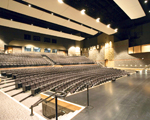The orchestra that I play in used to perform at local public schools. The high school auditoria that we regularly used were so-so for acoustics, but we learned to appreciate them when a scheduling conflict bumped us to a junior high school for one concert. This auditorium ceiling was treated with a spray-on absorbing material that made it feel like we were playing into a sonic black hole. After we finished, it sounded like twenty people were clapping, which I hope there were more…maybe not if they couldn’t hear us.
I frequently encounter the misunderstanding that acoustical surfaces are absorptive by definition, which is what I suspect happened to this ill-fated auditorium. Someone knew that an auditorium must have acoustical surfaces and used an “acoustical surface” for the ceiling. Problem is that auditorium ceilings should be reflective and/or diffusive, not absorptive, so that the sound can be projected into the audience.
For someone who is not an acoustician, knowing where to locate absorptive, reflective, diffusive and sound blocking surfaces can be very confusing. Acoustical consultants are trained and experienced in this area and know what surfaces and materials to use to obtain the right results for the use of each space. In schools, this consideration extends beyond the auditorium and music spaces to classrooms, media centers, cafeterias, gymnasiums, natatoriums and counseling offices. Each space has its own oral communication needs, which necessitates the careful selection of appropriate materials to provide the best acoustical environment for students and teachers. Poor acoustical environments hinder learning, which goes against the purpose of a school.
The good news is a lot of schools are getting it right. Or better said – architects are getting it right. When architects, school districts, and acoustical consultants work together, learning environments are optimized for communication. This benefits everyone from students to teachers, and sometimes even the local orchestra.
